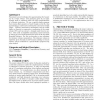Free Online Productivity Tools
i2Speak
i2Symbol
i2OCR
iTex2Img
iWeb2Print
iWeb2Shot
i2Type
iPdf2Split
iPdf2Merge
i2Bopomofo
i2Arabic
i2Style
i2Image
i2PDF
iLatex2Rtf
Sci2ools
106
Voted
SMA
2010
ACM
2010
ACM
Conservative swept volume boundary approximation
We present a novel technique for approximating the boundary of a swept volume. The generator given by an input triangle mesh is rendered under all rigid transformations of a discrete trajectory. We use a special shader program that creates offset geometry of each triangle on the fly, thus guaranteeing a conservative rasterization and correct depth values. Utilizing rasterization mechanisms and the depth buffer we then get a conservative voxelization of the swept volume (SV) and can extract a triangle mesh from its surface. This mesh is simplified maintaining conservativeness as well as an error bound measured in terms of the one-sided Hausdorff distance. For this we introduce a new technique for tolerance volume computation. The tolerance volume is implicitly given through six 2D-textures residing in texture memory and is evaluated in a special shader program only when needed. Categories and Subject Descriptors I.3.5 [Computer Graphics]: Computational Geometry and Object Modeling Gene...
Related Content
| Added | 06 Dec 2010 |
| Updated | 06 Dec 2010 |
| Type | Conference |
| Year | 2010 |
| Where | SMA |
| Authors | Andreas von Dziegielewski, R. Erbes, Elmar Schömer |
Comments (0)

